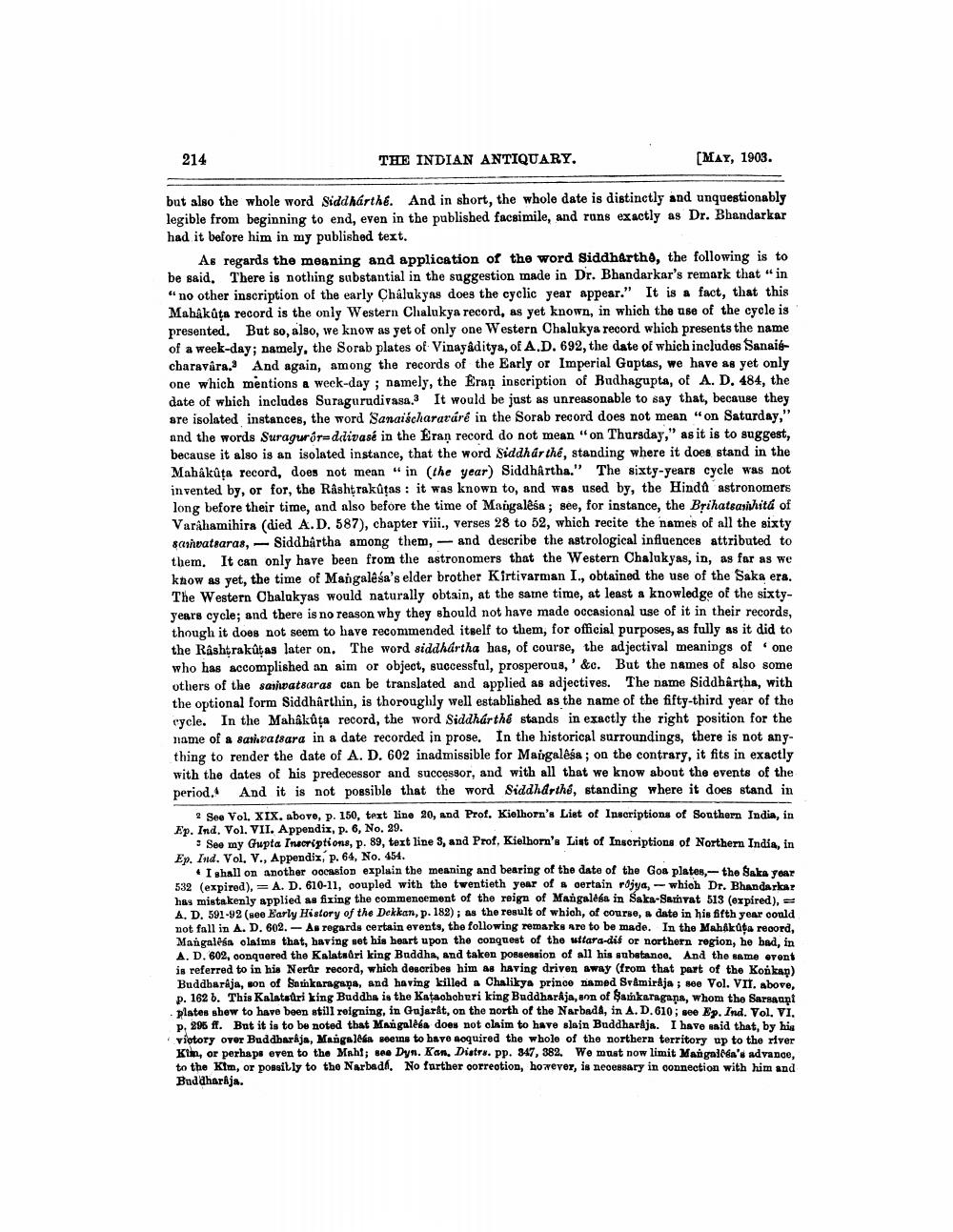________________
214
THE INDIAN ANTIQUARY.
[MAY, 1903.
but also the whole word Siddharthe. And in short, the whole date is distinctly and unquestionably legible from beginning to end, even in the published facsimile, and runs exactly as Dr. Bhandarkar had it before him in my published text.
As regards the meaning and application of the word Siddharthe, the following is to be said. There is nothing substantial in the suggestion made in Dr. Bhandarkar's remark that " in " no other inscription of the early Châlukyas does the cyclic year appear." It is a fact, that this Mahákůţa record is the only Western Chalukya record, as yet known, in which the use of the cycle is presented. But so, also, we know as yet of only one Western Chalukya record which presents the name of a week-day; namely, the Sorab plates of Vinayaditya, of A.D. 692, the date of which includes Sanaischaravára. And again, among the records of the Early or Imperial Gaptas, we have as yet only one which mentions a week-day; namely, the Eran inscription of Budhagupta, of A. D. 484, the date of which includes Suragurudivasa. It would be just as unreasonable to say that, because they are isolated instances, the word Sanaischararáré in the Sorab record does not mean "on Saturday," and the words Suragurór=ddivasé in the Eraņ record do not mean "on Thursday," as it is to suggest, because it also is an isolated instance, that the word Siddharthé, standing where it does stand in the Mahákůța record, does not mean " in the year) Siddhartha." The sixty-years cycle was not invented by, or for, the Rashtrakūtas : it was known to, and was used by, the Hinda astronomers long before their time, and also before the time of Mangalēša; see, for instance, the Brihatsasishitá of Varahamihira (died A.D. 587), chapter viii., verses 28 to 52, which recite the names of all the sixty sarnvatsaras, - Siddhartha among them, and describe the astrological influences attributed to them. It can only have been from the astronomers that the Western Chalukyas, in, as far as we know as yet, the time of Mangalêsa's elder brother Kirtivarman I., obtained the use of the Saka era. The Western Chalukyas would naturally obtain, at the same time, at least a knowledge of the sixtyyears cycle; and there is no reason why they should not have made occasional use of it in their records, though it does not seem to have recommended itself to them, for official purposes, as fully as it did to the Rashtrakūtas later on. The word siddhartha has, of course, the adjectival meanings of one who has accomplished an aim or object, successful, prosperous,' &c. But the names of also some others of the saivatsaras can be translated and applied as adjectives. The name Siddhartha, with the optional form Siddharthin, is thoroughly well established as the name of the fifty-third year of the cycle. In the Mahâkůța record, the word Siddharthế stands in exactly the right position for the name of a samvatsara in a date recorded in prose. In the historical surroundings, there is not anything to render the date of A. D. 602 inadmissible for Mangalêsa ; on the contrary, it fits in exactly with the dates of his predecessor and successor, and with all that we know about the events of the period. And it is not possible that the word Siddharthé, standing where it does stand in
. See Vol. XIX. above, p. 150, text line 20, and Prof. Kielhorn's List of Inscriptions of Southern India, in Ep. Ind. Vol. VII. Appendix, p. 6, No. 29.
Seo my Gupta Inscriptions, p. 89, text line 3, and Prof, Kielhorn's List of Inscriptions of Northern India, in Ep. Ind. Vol. V., Appendix, p. 64, No. 454.
Lahall on another Ocasion explain the meaning and bearing of the date of the God plates-the Saka TAAP 532 (expired). = A. D. 610-11, coupled with the twentieth year of certain rdjya, which Dr. Bhandarka has mistakenly applied as fizing the commencement of the reign of Mangaldss in Saka-Sathyat 313 (oxpired). A. D. 591-92 (noo Harly History of the Dekkan, p. 182); as the result of which, of course, a date in his fifth year oonld not fall in A. D. 602. -As regards certain events, the following remarks are to be made. In the Mahaka record, Mangalla laima that, having set his heart upon the conquest of the uttara-dis or northern region, he bad, in A. D. 602, oonquered the Kalatari king Buddha, and taken possession of all his substance. And the same event is referred to in his Nerar record, which describes him as having driven away (from that part of the Konkan) Buddbarja, son of Batinkaragspa, and having killed a Chalikya princo named Svemirkja; see Vol. VII, above, p. 162 b. This Kalaturi king Buddha is the Katachohuri king Buddharkja, ann of Bankaragana, whom the Sarsaari plates show to have been still reigning, in Gujarat, on the north of the Narbada, in A.D. 610, se Ey. Ind. Vol. VI. p. 295 ft. But it is to be noted that Mangaleia does not claim to have slain Buddharija. I have said that, by his victory over Buddbarája, Mangalla seins to have acquired the whole of the northern territory up to the river Kiin, or perhaps even to the Maht; see Dyn. Kan, Distra. Pp. 347, 382. We must now limit Mangalla's advance, to the Kim, or possilly to the Narbadh. No further correotion, however, is necessary in connection with him and Buddharija.




